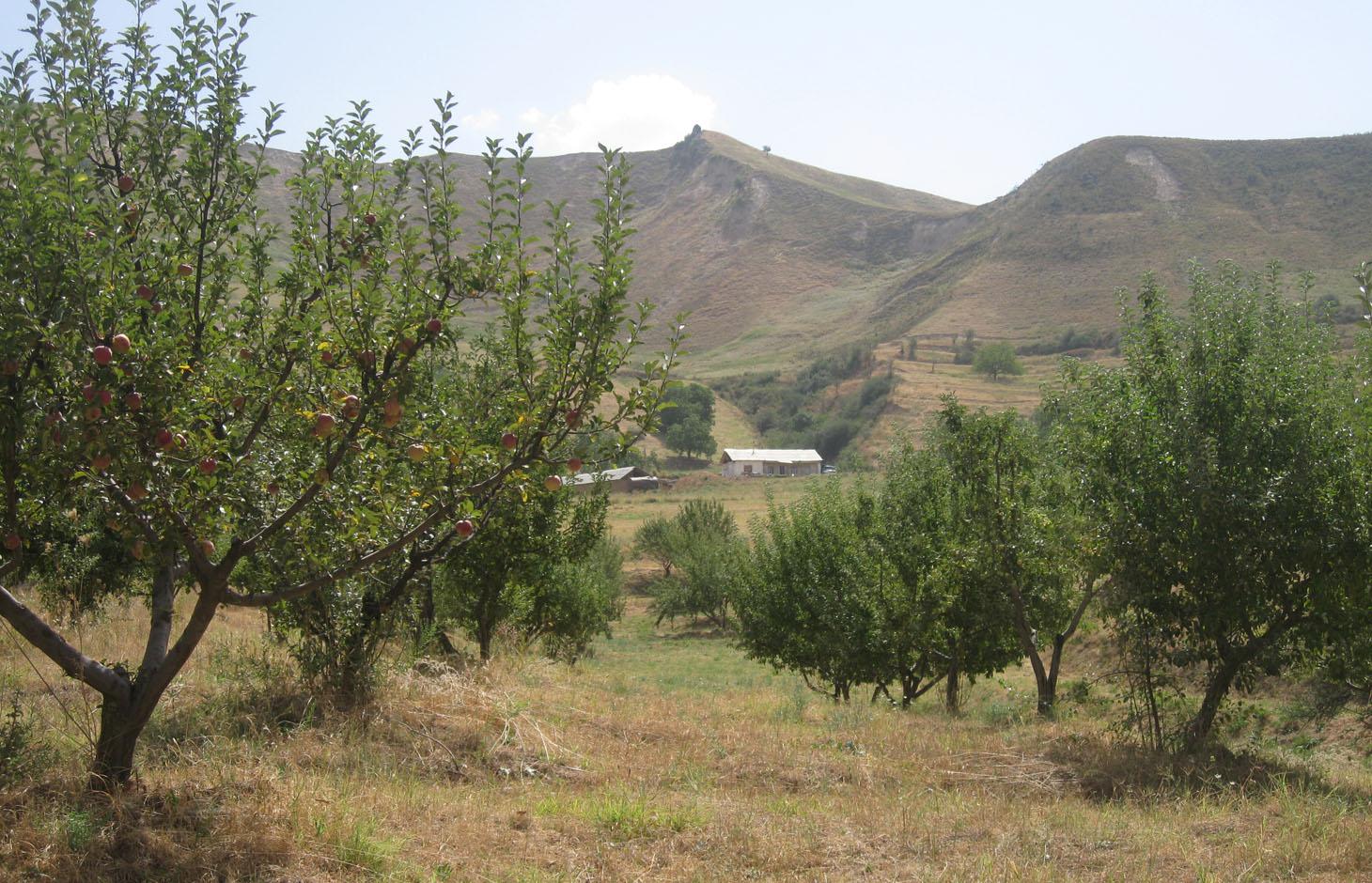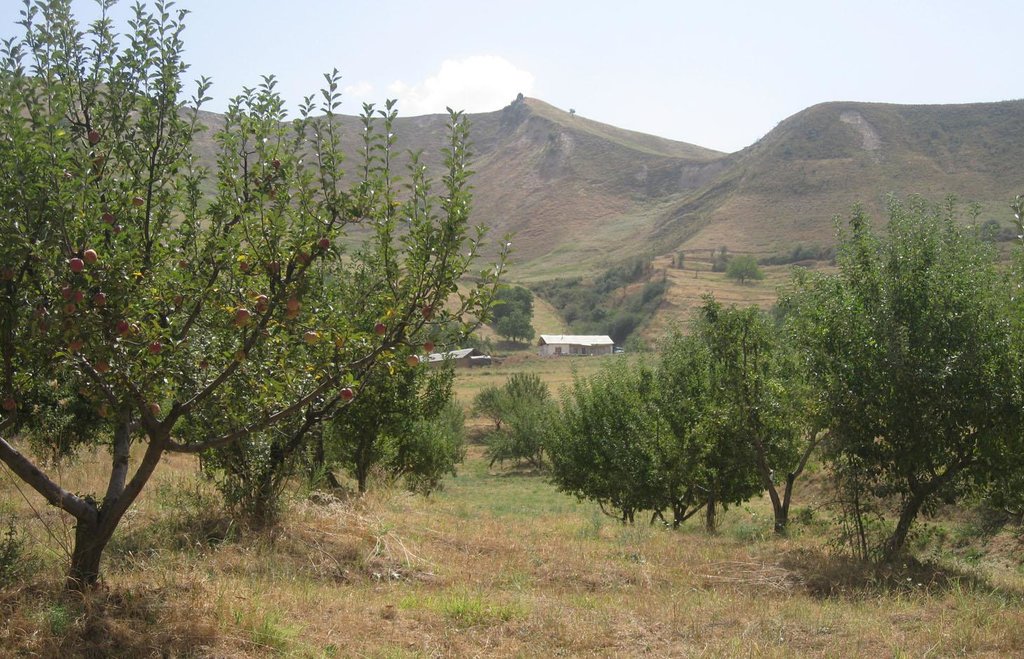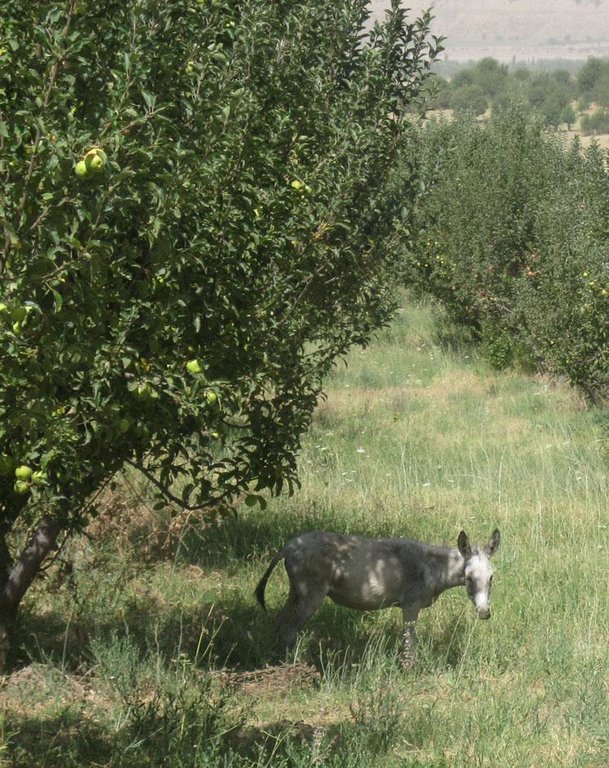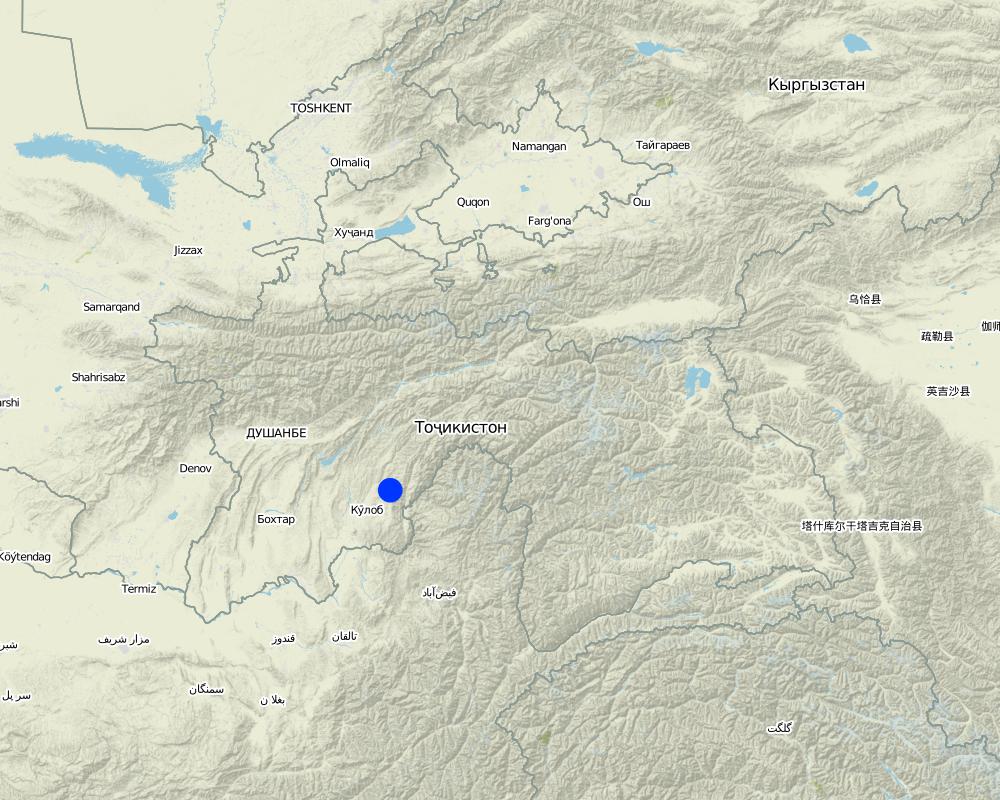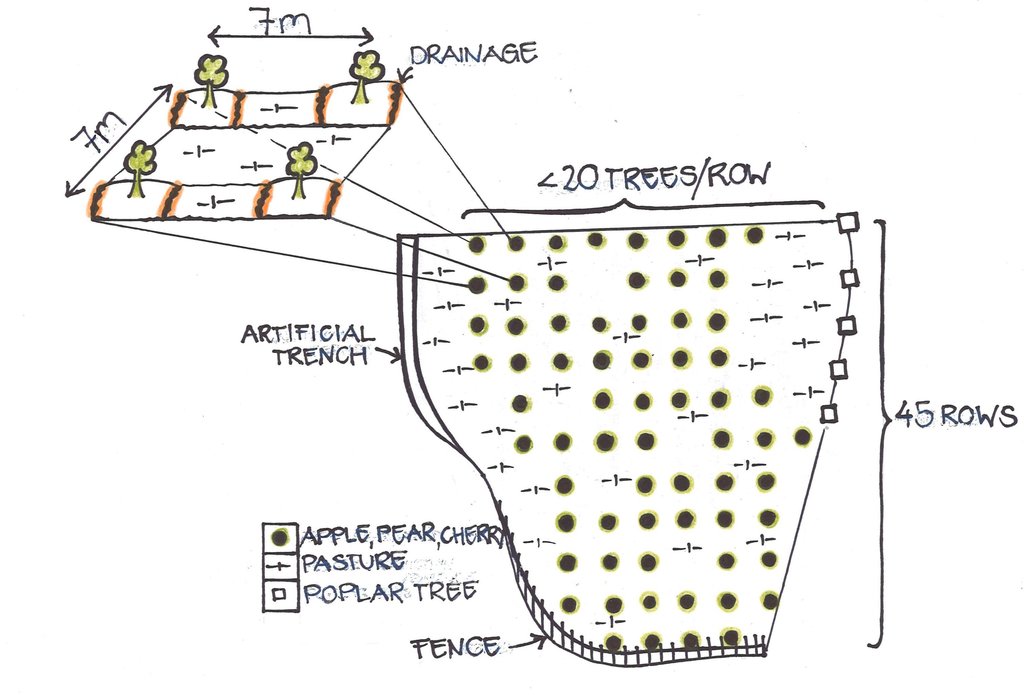Silvo-pastoralism: Orchard with integrated grazing and fodder production [Tajikistan]
- Creation:
- Update:
- Compiler: Malgorzata Conder
- Editor: –
- Reviewers: Deborah Niggli, Alexandra Gavilano
technologies_1554 - Tajikistan
View sections
Expand all Collapse all1. General information
1.2 Contact details of resource persons and institutions involved in the assessment and documentation of the Technology
SLM specialist:
Name of the institution(s) which facilitated the documentation/ evaluation of the Technology (if relevant)
NCCR North-South (NCCR North-South) - Kyrgyzstan1.3 Conditions regarding the use of data documented through WOCAT
The compiler and key resource person(s) accept the conditions regarding the use of data documented through WOCAT:
Yes
1.4 Declaration on sustainability of the described Technology
Is the Technology described here problematic with regard to land degradation, so that it cannot be declared a sustainable land management technology?
No
2. Description of the SLM Technology
2.1 Short description of the Technology
Definition of the Technology:
Increased productivity of the land by planting fruit trees and conserving the land by restricting the access of livestock resulting in improved runoff retention
2.2 Detailed description of the Technology
Description:
In Soviet times, this area of totally 40 ha comprised terraces and walnut trees in the steep foothills and pastures in the lower and flatter part. After the collapse of the Soviet Era, many similar areas got degraded due to uncontrolled grazing and overuse of natural resources. The area described in this documentation, in contrast, was taken over by a family in 1991. Within the whole area of 40 ha, roads were built to improve the access and 6000 trees were planted, whereof 1200 fruit trees were planted on the pasture, conversing it into an orchard.
At present, the 6 ha of orchard are mainly consisting of three types of apple (white, golden and red), some pear and cherry trees. Several trees must have dried out or have been cut, as the farmer counts currently around 1000 fruit trees. The whole orchard is combined with pasture land. The farmer let his livestock graze in the orchard, and cuts the remaining grass in autumn, if there is still left.
The integrated orchard with pastureland and fodder production is partially fenced to hinder livestock entering his property. Furthermore, the orchard is within the range of vision which allows the farmer`s family to guard it.
The farmer who is managing the orchard today obtained the property of his father in order to continue the family project by his own initiative. By farming he ensures the livelihood of his family. Hence, he felt responsible to progress and improve the quality of life of his own family. The main reason for establishing the orchard within the grassland and to install fences, was to increase productivity of the land, bringin along beneficial effects on soil quality. According to his land users certificate, the main purpose of this land is to provide the local market with food products.
After planting, some of the seedlings were stolen or eaten by livestock from neighbouring farms. Initial labour input in the newly established orchard consisted of getting and planting the seedlings and applying pesticides. The trees are being maintained by pruning. Soil is loosened and drainage provided to increase water infiltration and to protect the trees additionally from parasites. The pasture is grazed by the livestock of the farmer. As the family only has a small number of livestock, grass is cut afterwards and used as fodder. Half of the fodder harvest belongs to the hired worker, the other half belongs to the farmer. The other tasks are executed by the farmer and his family.
The climate is semi-arid with precipitation (800mm totally) mainly during winter and spring time. Altitude is around 1380 m asl. The plot is located at the foothill, with the wider riverbed and fan downstream and overgrazed hills upstream. Bordering with the property from above, a steep slope with a dense vegetation of grafted fruit trees and walnut trees stabilizes the soil.The farmer is living with the family on the property, near the village of Momandion. In the past many livestock from nearby entered the property and grazed there. Through better control and fences less livestock is entering. The property is located directly on the road to Muminabad, the center of the District with a market- 2 km away.Considering the establishment costs of the orchard, the farmer is a fairly whealthy man, nevertheless he had to rely on his family and friends in terms of the working input.The establishment phase was a time and money consuming
2.3 Photos of the Technology
2.5 Country/ region/ locations where the Technology has been applied and which are covered by this assessment
Country:
Tajikistan
Region/ State/ Province:
Khatlon, Tajikistan
Further specification of location:
Muminabad
Specify the spread of the Technology:
- evenly spread over an area
If precise area is not known, indicate approximate area covered:
- < 0.1 km2 (10 ha)
Comments:
Total area covered by the SLM Technology is 0.06 km2.
Orchard is within the farmer's land property of totally 40 ha
Map
×2.6 Date of implementation
If precise year is not known, indicate approximate date:
- 10-50 years ago
2.7 Introduction of the Technology
Specify how the Technology was introduced:
- through land users' innovation
Comments (type of project, etc.):
22 years ago
3. Classification of the SLM Technology
3.1 Main purpose(s) of the Technology
- improve production
- reduce, prevent, restore land degradation
3.2 Current land use type(s) where the Technology is applied

Cropland
- Tree and shrub cropping
Tree and shrub cropping - Specify crops:
- pome fruits (apples, pears, quinces, etc.)
- stone fruits (peach, apricot, cherry, plum, etc)

Grazing land
Extensive grazing:
- Semi-nomadic pastoralism
Comments:
Livestock density (if relevant):
50-100 LU /km2
Major land use problems (compiler’s opinion): No major problems because of the early implementation of the technology which prevented the area of being (over)grazed without control
Major land use problems (land users’ perception): The farmer is afraid of a possible landslide on his property. Another issue is the lack of a continuous fence, because still some unwanted livestock is able to enter the orchard. He installed a water point next to his house recently.
Other grazingland: agropastoralism: first grazing and if grass is left, then cut
3.3 Has land use changed due to the implementation of the Technology?

Grazing land
Extensive grazing:
- Semi-nomadic pastoralism
Comments:
Grazing land: Extensive grazing land
3.4 Water supply
Water supply for the land on which the Technology is applied:
- rainfed
3.5 SLM group to which the Technology belongs
- agroforestry
- pastoralism and grazing land management
3.6 SLM measures comprising the Technology

vegetative measures
- V1: Tree and shrub cover

management measures
- M1: Change of land use type
- M2: Change of management/ intensity level
Comments:
Type of vegetative measures: aligned: -contour
3.7 Main types of land degradation addressed by the Technology

soil erosion by water
- Wt: loss of topsoil/ surface erosion
- Wo: offsite degradation effects

physical soil deterioration
- Pc: compaction

biological degradation
- Bc: reduction of vegetation cover
Comments:
Main causes of degradation: overgrazing (uncontrolled)
Secondary causes of degradation: population pressure (increased livestock), governance / institutional (no or undeveloped pasture management after Soviet collapse)
3.8 Prevention, reduction, or restoration of land degradation
Specify the goal of the Technology with regard to land degradation:
- prevent land degradation
- reduce land degradation
4. Technical specifications, implementation activities, inputs, and costs
4.1 Technical drawing of the Technology
Technical specifications (related to technical drawing):
The orchard is situated within the farmers' property which is almost completely fenced by an artificial trench, thornbush fences, poplar trees and a natural steep slope. The orchard is 6 ha in size and consists of around 45 rows, with some 20 trees per row on average. In some places trees are missing due to drying out or cutting. Currently approximately 1000 fruit trees are growing. In between the tree rows and at the borders of the orchard, grass is growing and grazed by animals, and if not entirely grazed cut for haymaking in autumn.
The fruit trees grow at a distance of 7 meters. Around the trees the soil is loosened and a tiny trench is dug, the latter serving as a rainwater drainage.
Location: Momandion. Muminabad, Khatlon, Tajikistan
Date: 14.09.2012
Technical knowledge required for land users: moderate (Good knowledge for planting required, knowledge about maintenance activities is probably more widespread amongst farmers, idea of fencing is lacking)
Main technical functions: control of concentrated runoff: retain / trap, control of concentrated runoff: impede / retard, control of concentrated runoff: drain / divert, improvement of ground cover, improvement of topsoil structure (compaction), spatial arrangement and diversification of land use
Secondary technical functions: control of raindrop splash, control of dispersed runoff: retain / trap, control of dispersed runoff: impede / retard, stabilisation of soil (eg by tree roots against land slides), increase in organic matter, increase in nutrient availability (supply, recycling,…), increase / maintain water stored in soil, increase of groundwater level / recharge of groundwater, increase of biomass (quantity), promotion of vegetation species and varieties (quality, eg palatable fodder), reduction of dry material (fuel for wildfires)
Aligned: -contour
Number of plants per (ha): 200
Vertical interval between rows / strips / blocks (m): 7
Spacing between rows / strips / blocks (m): 7
Vertical interval within rows / strips / blocks (m): 7
Width within rows / strips / blocks (m): 7
Fruit trees / shrubs species: Apple, pear, cherry
Change of land use type: change of pasture land into an orchard with integrated pasture land and fodder production (Silvopastoralism)
Change of land use practices / intensity level: Fencing hence more extensive and controlled grazing
Author:
Conder Malgorzata
4.2 General information regarding the calculation of inputs and costs
other/ national currency (specify):
Somoni
If relevant, indicate exchange rate from USD to local currency (e.g. 1 USD = 79.9 Brazilian Real): 1 USD =:
4.83
Indicate average wage cost of hired labour per day:
12.40
4.3 Establishment activities
| Activity | Timing (season) | |
|---|---|---|
| 1. | Buying and transport of fruit seedlings (totally 6000 seedling, whereof 1200 seedlings on for the orchard of 6 ha) | once |
| 2. | Planting fruit tree seedlings (totally 6000 seedlings, whereof 1200 seedlings for the orchard), cost according to planted trees (3 TJS per tree) | once |
| 3. | Partial fencing (of around 200m) along the property, 10.5 days, 3-4 persons | 1991 |
| 4. | Building roads for access to the house | 1991 |
4.4 Costs and inputs needed for establishment
| Specify input | Unit | Quantity | Costs per Unit | Total costs per input | % of costs borne by land users | |
|---|---|---|---|---|---|---|
| Labour | labour | ha | 1.0 | 194.9 | 194.9 | 100.0 |
| Equipment | machine use | ha | 1.0 | 0.7 | 0.7 | 100.0 |
| Plant material | seedlings | ha | 1.0 | 207.0 | 207.0 | 100.0 |
| Construction material | fence | ha | 1.0 | 124.2 | 124.2 | 100.0 |
| Total costs for establishment of the Technology | 526.8 | |||||
| Total costs for establishment of the Technology in USD | 109.07 | |||||
Comments:
Duration of establishment phase: 1 month(s)
4.5 Maintenance/ recurrent activities
| Activity | Timing/ frequency | |
|---|---|---|
| 1. | Pruning of 400 trees, ca. 40 days, 1 person, 3 TJS per tree (all trees pruned every 3 years) | spring/ once a year |
| 2. | Soil loosening around 1000 fruit trees, ca. 25 days (5 h/day), 1 person | spring/ once a year |
| 3. | Pesticides spraying once (should be done 2-3 times), 4 days (ca.5 h/d), 1 person | End of May/ once a year |
| 4. | After several years: Harvesting fruits (mainly apples) | September/every year |
| 5. | Cutting grass, by 10 people, one month, hours per day unknown. Half of straw harvest for owner, other half for the mowers as salary (4-5 Somoni/bundle). Total salary: 1000 bandles | End of summer |
| 6. | Guarding the orchard | all the time |
4.6 Costs and inputs needed for maintenance/ recurrent activities (per year)
| Specify input | Unit | Quantity | Costs per Unit | Total costs per input | % of costs borne by land users | |
|---|---|---|---|---|---|---|
| Labour | labour | ha | 1.0 | 383.3 | 383.3 | 100.0 |
| Fertilizers and biocides | pesticides | ha | 1.0 | 7.8 | 7.8 | 100.0 |
| Total costs for maintenance of the Technology | 391.1 | |||||
| Total costs for maintenance of the Technology in USD | 80.97 | |||||
Comments:
The structural fencing is adapted from T_TAJ047. Working hours are approximate as the work was done a long time ago, with the help of many relatives with different work times. No overview over the exact work and cost input exists, tools were mainly borrowed, prices unknown. Road building done in the past was not included, because current costs were difficult to estimate. Work as guardening is not monetarised. Apple harvesting as recurrent activity (vegetative measure) is derived from T_TAJ013. In the cost summary, the fencing was calculated proportionally to one ha.
4.7 Most important factors affecting the costs
Describe the most determinate factors affecting the costs:
Apart from the orchard, the whole property was rebuilt with roads, fences and tree planting which caused high initial costs during the establishment phase.
5. Natural and human environment
5.1 Climate
Annual rainfall
- < 250 mm
- 251-500 mm
- 501-750 mm
- 751-1,000 mm
- 1,001-1,500 mm
- 1,501-2,000 mm
- 2,001-3,000 mm
- 3,001-4,000 mm
- > 4,000 mm
Specifications/ comments on rainfall:
Totally 800 mm: 700mm in winter-spring, July-Sept dry season (At 1200m asl, weather station Muminabad)
Agro-climatic zone
- sub-humid
Thermal climate class: temperate
5.2 Topography
Slopes on average:
- flat (0-2%)
- gentle (3-5%)
- moderate (6-10%)
- rolling (11-15%)
- hilly (16-30%)
- steep (31-60%)
- very steep (>60%)
Landforms:
- plateau/plains
- ridges
- mountain slopes
- hill slopes
- footslopes
- valley floors
Altitudinal zone:
- 0-100 m a.s.l.
- 101-500 m a.s.l.
- 501-1,000 m a.s.l.
- 1,001-1,500 m a.s.l.
- 1,501-2,000 m a.s.l.
- 2,001-2,500 m a.s.l.
- 2,501-3,000 m a.s.l.
- 3,001-4,000 m a.s.l.
- > 4,000 m a.s.l.
5.3 Soils
Soil depth on average:
- very shallow (0-20 cm)
- shallow (21-50 cm)
- moderately deep (51-80 cm)
- deep (81-120 cm)
- very deep (> 120 cm)
Soil texture (topsoil):
- medium (loamy, silty)
- fine/ heavy (clay)
Topsoil organic matter:
- medium (1-3%)
5.4 Water availability and quality
Ground water table:
< 5 m
Availability of surface water:
poor/ none
Water quality (untreated):
good drinking water
5.5 Biodiversity
Species diversity:
- medium
5.6 Characteristics of land users applying the Technology
Off-farm income:
- less than 10% of all income
Relative level of wealth:
- rich
Individuals or groups:
- individual/ household
Gender:
- men
Indicate other relevant characteristics of the land users:
Land users applying the Technology are mainly common / average land users
Population density: 100-200 persons/km2
Annual population growth: 1% - 2%
5.7 Average area of land used by land users applying the Technology
- < 0.5 ha
- 0.5-1 ha
- 1-2 ha
- 2-5 ha
- 5-15 ha
- 15-50 ha
- 50-100 ha
- 100-500 ha
- 500-1,000 ha
- 1,000-10,000 ha
- > 10,000 ha
Is this considered small-, medium- or large-scale (referring to local context)?
- medium-scale
5.8 Land ownership, land use rights, and water use rights
Land ownership:
- state
Land use rights:
- leased
Water use rights:
- communal (organized)
- individual
Comments:
Land ownership is based on the land user certificate conferred by the government.
5.9 Access to services and infrastructure
health:
- poor
- moderate
- good
education:
- poor
- moderate
- good
technical assistance:
- poor
- moderate
- good
employment (e.g. off-farm):
- poor
- moderate
- good
markets:
- poor
- moderate
- good
energy:
- poor
- moderate
- good
roads and transport:
- poor
- moderate
- good
drinking water and sanitation:
- poor
- moderate
- good
financial services:
- poor
- moderate
- good
6. Impacts and concluding statements
6.1 On-site impacts the Technology has shown
Socio-economic impacts
Production
crop production
fodder production
fodder quality
animal production
Comments/ specify:
As the area of the orchard with pasture is fenced it is not an communal pasture anymore as it was before
wood production
Comments/ specify:
From pruning
product diversity
production area
Water availability and quality
demand for irrigation water
Income and costs
expenses on agricultural inputs
farm income
diversity of income sources
Socio-cultural impacts
food security/ self-sufficiency
health situation
conflict mitigation
contribution to human well-being
Comments/ specify:
Products for market leading to higher income, sharing of some knowledge about management of private land enhances dissemination and exchange of information/knowledge.
Ecological impacts
Water cycle/ runoff
surface runoff
Soil
soil moisture
soil cover
soil loss
soil crusting/ sealing
soil compaction
nutrient cycling/ recharge
soil organic matter/ below ground C
Biodiversity: vegetation, animals
biomass/ above ground C
pest/ disease control
Climate and disaster risk reduction
fire risk
6.2 Off-site impacts the Technology has shown
downstream flooding
buffering/ filtering capacity
damage on neighbours' fields
6.3 Exposure and sensitivity of the Technology to gradual climate change and climate-related extremes/ disasters (as perceived by land users)
Gradual climate change
Gradual climate change
| Season | increase or decrease | How does the Technology cope with it? | |
|---|---|---|---|
| annual temperature | increase | not well |
Climate-related extremes (disasters)
Meteorological disasters
| How does the Technology cope with it? | |
|---|---|
| local rainstorm | well |
| local windstorm | well |
Climatological disasters
| How does the Technology cope with it? | |
|---|---|
| drought | not well |
Hydrological disasters
| How does the Technology cope with it? | |
|---|---|
| general (river) flood | well |
Other climate-related consequences
Other climate-related consequences
| How does the Technology cope with it? | |
|---|---|
| reduced growing period | not well |
6.4 Cost-benefit analysis
How do the benefits compare with the establishment costs (from land users’ perspective)?
Short-term returns:
slightly positive
Long-term returns:
positive
How do the benefits compare with the maintenance/ recurrent costs (from land users' perspective)?
Short-term returns:
positive
Long-term returns:
positive
Comments:
Family project to improve the quality of life of the family. Costs were high at the beginning with little outcomes, now there is less labour required and the outcome is high.
6.5 Adoption of the Technology
Comments:
1 land user families have adopted the Technology without any external material support
Even though they neighbours see the whealty orchard, the farmer din not see any other farmers adapting this Technology. Reasons are unknwon.
There is no trend towards spontaneous adoption of the Technology
6.7 Strengths/ advantages/ opportunities of the Technology
| Strengths/ advantages/ opportunities in the land user’s view |
|---|
| Giving good yield and "cash crop" hence having success in the project of the family |
| Better quality of fodder and less damages due to intrusive livestock |
| Strengths/ advantages/ opportunities in the compiler’s or other key resource person’s view |
|---|
| Thanks to the establishment time, right after the collapse of the Soviet Union, when land was generally well conserved, the technology worked as a preventive measure. |
| Silvopastoralism not only raises productivity of the same plot as an orchard and pasture is combined, but also enables mutual benefits (p.e.rooting system raises soil moisture, which is again improving vegetation cover). |
| The technology might work as exemplary model for other farmers |
6.8 Weaknesses/ disadvantages/ risks of the Technology and ways of overcoming them
| Weaknesses/ disadvantages/ risks in the land user’s view | How can they be overcome? |
|---|---|
| There is always work to do, without input no (good) output. |
| Weaknesses/ disadvantages/ risks in the compiler’s or other key resource person’s view | How can they be overcome? |
|---|---|
| For the farmer, the economic benefit is more important than the ecologic benefit. Especially, there is missing sensibility of the farmer concerning the application of pesticides (quantity, type). | A workshop which provides guidelines on optimal use of pesticides (type and quantities of pesticides, timing and frequency of application etc.) |
| The establishment of orchards is more efficient on big plots of land, which often prevents poor farmers with small plots from establishing orchards. | Creating incentives to change land use, by combining plots from different land owners, which will allow to share costs for establishment and maintenance. Yields should be clearly attributed to the individual farmers. |
7. References and links
7.1 Methods/ sources of information
- field visits, field surveys
- interviews with land users
When were the data compiled (in the field)?
19/07/2012
Links and modules
Expand all Collapse allLinks
No links
Modules
No modules


